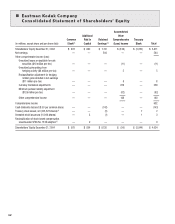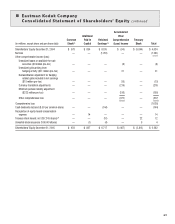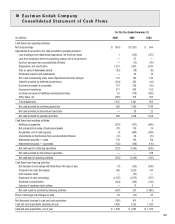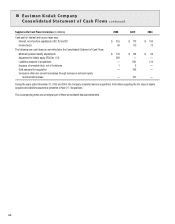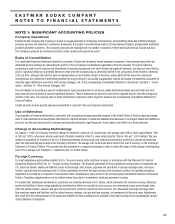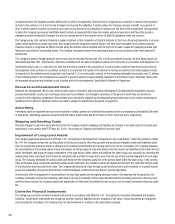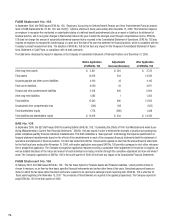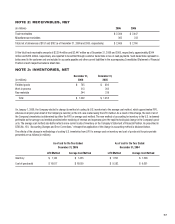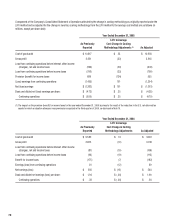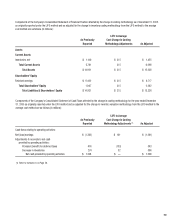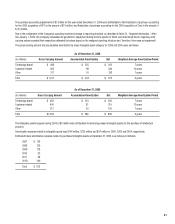Kodak 2006 Annual Report Download - page 79
Download and view the complete annual report
Please find page 79 of the 2006 Kodak annual report below. You can navigate through the pages in the report by either clicking on the pages listed below, or by using the keyword search tool below to find specific information within the annual report.
Earnings Per Share
Basic earnings-per-share computations are based on the weighted-average number of shares of common stock outstanding during the year. Diluted
earnings-per-share calculations reflect the assumed exercise and conversion of employee stock options that have an exercise price that is below the
average market price of the common shares for the respective periods as well as shares related to the assumed conversion of the Convertible Securi-
ties, if dilutive. The reconciliation between the numerator and denominator of the basic and diluted earnings-per-share computations is presented as
follows:
2006 2005 2004
Numerator:
(Loss) earnings from continuing operations used in
basic net (loss) earnings per share $ (600) $ (1,354) $ 69
Denominator:
Number of common shares used in basic net earnings per share 287.3 287.9 286.6
Effect of dilutive securities:
Employee stock options — — 0.2
Number of common shares used in diluted net earnings per share 287.3 287.9 286.8
For the years ended December 31, 2006 and 2005, outstanding options to purchase the Company’s common stock of 34.6 million and 36.0 million
shares, respectively, were not included in the computation of diluted earnings per share because the Company reported a net loss from continuing op-
erations; therefore, the effect would be anti-dilutive. For the year ended December 31, 2004, options to purchase 32.5 million shares of common stock
were outstanding at a weighted-average per share price of $52.47, but were not included in the computation of diluted earnings per share because the
option’s exercise price was greater than the average market price of the common shares for the period, and the effect would be anti-dilutive.
The Company currently has approximately $575 million in contingent convertible notes (the Convertible Securities) outstanding that were issued in Oc-
tober 2003. Interest on the Convertible Securities accrues at a rate of 3.375% and is payable semi-annually. The Convertible Securities are convertible
at an initial conversion rate of 32.2373 shares of the Company’s common stock for each $1,000 principal of the Convertible Securities. The Company’s
diluted net earnings per share exclude the effect of the Convertible Securities, as they were anti-dilutive for all periods presented.
Stock-Based Compensation
On January 1, 2005, the Company early adopted the stock option expensing rules of Statement of Financial Accounting Standards (SFAS) No. 123R,
“Share-Based Payment,” as interpreted by Financial Accounting Standards Board (FASB) Staff Positions No. 123R-1, 123R-2, 123R-3, 123R-4,
123R-5, and 123R-6, using the fair value recognition provisions of SFAS No. 123, “Accounting for Stock-Based Compensation.” The Company
recognized expense under SFAS No. 123R in the amount of $8 million and $16 million for the years ended December 31, 2006 and 2005, respectively.
The related impact on basic and diluted earnings per share for the years ended December 31, 2006 and 2005 was a reduction of $.03 and $.06,
respectively. The impacts on the Company’s cash flow for 2006 and 2005 were not material.
Upon the adoption of SFAS No. 123R in January 2005, stock-based compensation costs are included in the costs capitalized in inventory at period
end. Under the pro forma disclosures previously provided under SFAS No. 123, the Company was not assuming the capitalization of such costs.
For all awards issued after adoption of SFAS No. 123R, the Company changed from the nominal-vesting approach to the non-substantive vesting
approach for purposes of accounting for retirement eligible participants. The impact of applying the nominal-vesting approach vs. the non-substan-
tive approach upon adoption of SFAS No. 123R in 2005 was immaterial. The Company has a policy of issuing shares of treasury stock to satisfy share
option exercises. Based on an estimate of option exercises, the Company does not expect option exercises to result in the repurchase of stock during
2007.
The Company previously accounted for its employee stock incentive plans under Accounting Principles Board (APB) Opinion No. 25, “Accounting for
Stock Issued to Employees,” and the related interpretations under FASB Interpretation No. 44, “Accounting for Certain Transactions Involving Stock
Compensation.” Accordingly, no stock-based employee compensation cost was reflected in net earnings for the year ended December 31, 2004, as all
options granted had an exercise price equal to the market value of the underlying common stock on the date of grant.


